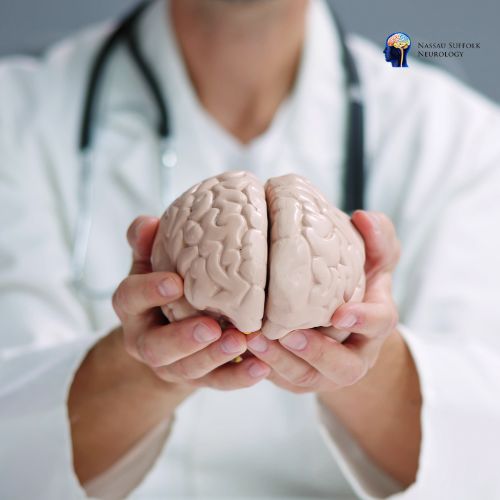Seizures are sudden, uncontrolled electrical disturbances in the brain. They can cause changes in behavior, movements, feelings, or consciousness. While some seizures are easy to recognize, others may be subtle or mistaken for other conditions. At Nassau Suffolk Neurology, we provide expert care for individuals experiencing seizures and epilepsy, helping patients understand their condition, symptoms, causes, and treatment options.
Seizure Symptoms: What to Look For
The symptoms of a seizure can vary widely depending on the type of seizure, where it starts in the brain, and whether consciousness is affected. Common seizure symptoms include:
- Uncontrollable jerking of the arms or legs
- Staring spells or unresponsiveness (often seen in absence seizures)
- Confusion or disorientation after the seizure
- Sudden collapse or falling (may indicate an atonic seizure)
- Muscle stiffness (common in tonic seizures)
- Brief muscle twitches or jerks (myoclonic seizures)
- Unusual sensations like tingling, flashing lights, or strange smells
- Loss of awareness or impaired consciousness (focal onset impaired awareness seizures)
These symptoms may last from a few seconds to several minutes. If a seizure lasts longer than 5 minutes, it is a medical emergency.

Types of Seizures and Their Symptoms
There are different types of seizures, classified as focal or generalized, depending on how and where they begin in the brain.
Focal Seizures
Also known as partial seizures, these start in one area of the brain. There are two main types of focal seizures:
- Focal onset aware seizures: You remain conscious and aware. Symptoms of focal seizures may include tingling, unusual smells, or twitching in one part of the body.
- Focal onset impaired awareness seizures: You experience altered awareness or responsiveness. Symptoms may include blank staring, automatic movements (like lip smacking), or confusion afterward.
Generalized Seizures
These involve both sides of the brain and often affect consciousness. Types of generalized seizures include:
- Tonic-clonic seizures (formerly grand mal seizures): These cause stiffening of the body followed by rhythmic jerking movements, and often involve loss of consciousness.
- Absence seizures (previously petit mal seizures): Brief staring episodes, often seen in children.
- Myoclonic seizures: Sudden jerks of muscles.
- Atonic seizures: Sudden loss of muscle tone, causing the person to collapse.
- Tonic seizures: Muscle stiffening without jerking.
- Clonic seizures: Rhythmic jerking without the stiffening phase.
Each kind of seizure presents differently, and symptoms depend on the brain area involved.
Seizure Causes and Triggers
Seizures are caused by abnormal electrical activity in the brain. The cause of epilepsy is often unknown, but potential seizure causes include:
- Brain injury or trauma
- Stroke
- Brain infections like meningitis
- Brain tumors
- Genetic conditions
- Neurological disorders
A seizure may also be triggered by:
- Sleep deprivation
- Stress
- Alcohol or drug use
- Flashing lights
- Hormonal changes (e.g., seizures during pregnancy pose dangers)
- Missed medications
Seizure triggers vary by individual. People with seizures often learn to recognize patterns that may trigger seizures and work with specialists to avoid them.

First-Time Seizure or Single Seizure: What to Do
If someone has a seizure for the first time (first-time seizure or single seizure), it is critical to seek medical evaluation. First seizure in adults could be a warning sign of a more serious underlying brain condition that causes seizures. Even one seizure requires investigation to understand its cause.
When to See a Neurologist
You should see a neurologist at Nassau Suffolk Neurology if:
- You’ve experienced a first seizure
- Your seizure lasts longer than 5 minutes
- You have recurring seizures
- You may not remember the seizure
- You notice symptoms such as tingling, staring, or confusion
Diagnosis and Treatment for Epilepsy and Seizures
Diagnosing seizures and epilepsy involves reviewing symptoms, performing neurological exams, and conducting tests like EEG and brain imaging. People with epilepsy are diagnosed after two or more unprovoked seizures at least 24 hours apart.
Treatment for epilepsy and treatment options for seizures may include:
- Anti-seizure medications to control seizures
- Lifestyle changes to avoid seizure triggers
- Nerve stimulation therapy
- Dietary therapy (like the ketogenic diet)
- Surgery (for people whose seizures aren’t controlled by medication)
With the right treatment options, many people with epilepsy live full, active lives.
What to Do if You See Someone Having a Seizure
If you see someone having a seizure, follow these steps:
-
Keep them safe: Move objects out of the way.
-
Turn them onto their side to prevent choking.
-
Time the seizure. Call 911 if the seizure lasts longer than 5 minutes.
-
Do not restrain them or put anything in their mouth.
-
Stay with them until they are fully alert.
Remember: Not everyone who has a seizure has epilepsy, but all seizures should be evaluated.
Nassau Suffolk Neurology: Your Partner in Seizure Care
Whether you’ve had a first seizure, are living with epilepsy, or are seeking better control of your seizure disorder, Nassau Suffolk Neurology is here to help. Our expert neurologists provide personalized care, advanced diagnostics, and comprehensive treatment options for seizures and epilepsy. Serving Long Island with offices in both Nassau and Suffolk Counties. Contact us today to schedule a consultation and take control of your neurological health.
